Employability Skills Development and Application in the NHS Sector
VerifiedAdded on 2024/05/14
|20
|4251
|141
Report
AI Summary
This assignment provides a comprehensive overview of employability skills within the National Health Service (NHS). It begins with a self-appraisal form, evaluating personal responsibilities and performance as a team leader, including patient care, medication assistance, and record-keeping. The report utilizes the SMART tool for evaluating personal effectiveness and identifies areas for improvement through SWOT analysis, incorporating Maslow's hierarchy of needs and Hertzberg's two-factor theory for motivational insights. It addresses problems like communication gaps, unnecessary care, lack of transparency, and ineffective technology use, proposing strategies based on scanning, analysis, response, and assessment, further employing the PDCA cycle for continuous improvement. Time management strategies, including prioritization and delegation, are discussed to enhance professional efficiency. Finally, the assignment includes a collaborative team dynamics journal, reflecting on team meetings, problem-solving, and decision-making processes, concluding with the importance of various employability skills in the health and social care sector. Desklib provides past papers and solved assignments for students.
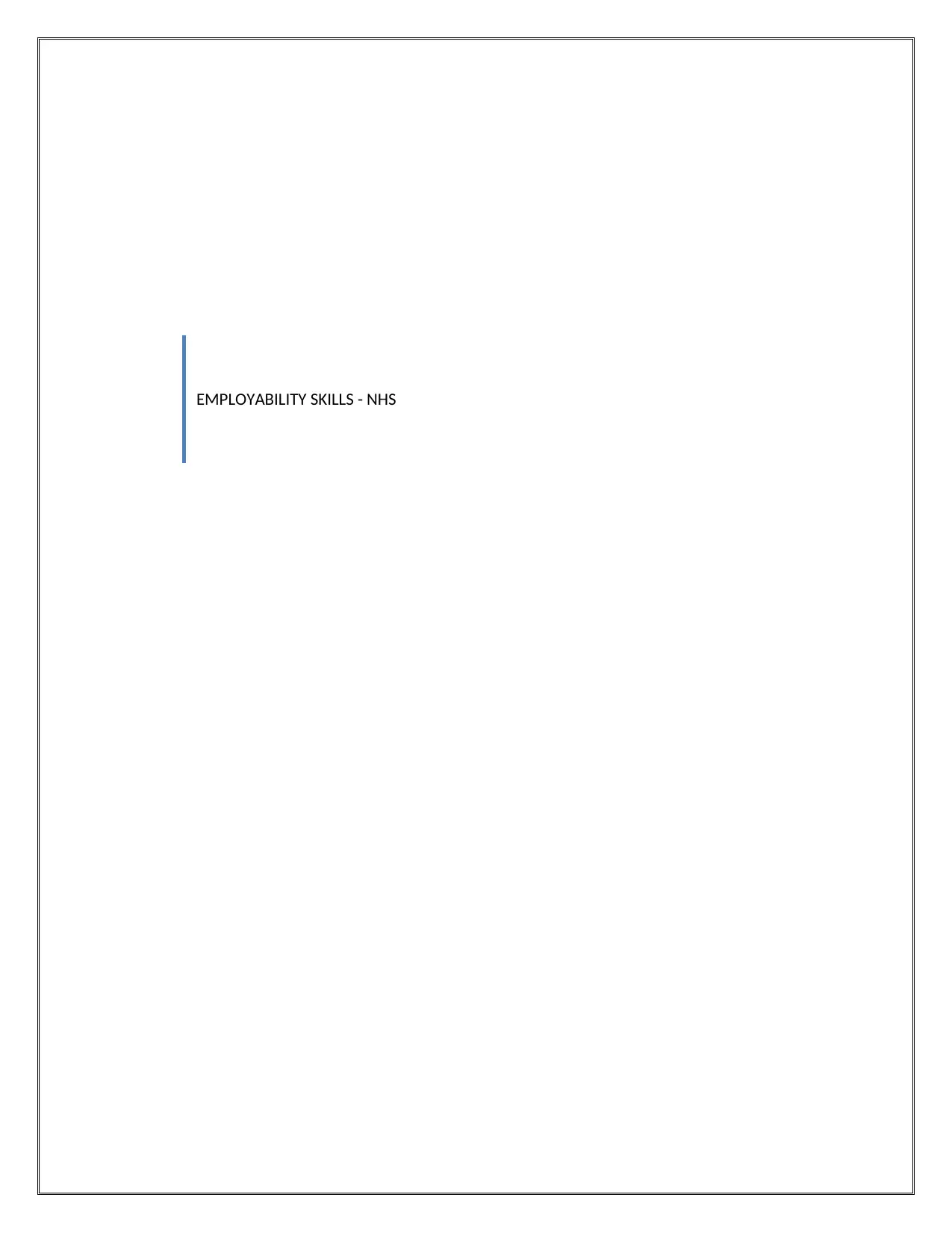
EMPLOYABILITY SKILLS - NHS
Paraphrase This Document
Need a fresh take? Get an instant paraphrase of this document with our AI Paraphraser
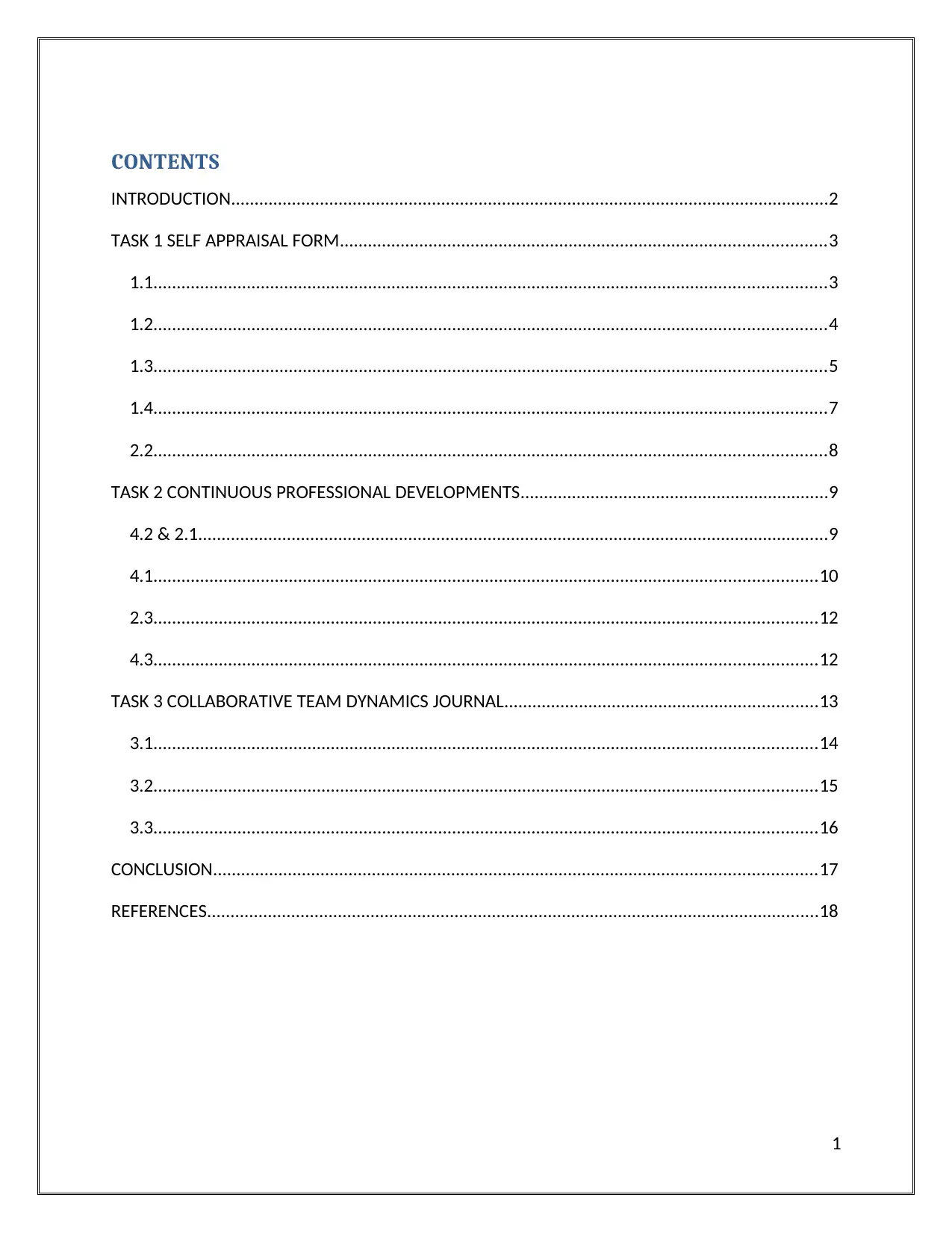
CONTENTS
INTRODUCTION................................................................................................................................2
TASK 1 SELF APPRAISAL FORM........................................................................................................3
1.1................................................................................................................................................3
1.2................................................................................................................................................4
1.3................................................................................................................................................5
1.4................................................................................................................................................7
2.2................................................................................................................................................8
TASK 2 CONTINUOUS PROFESSIONAL DEVELOPMENTS..................................................................9
4.2 & 2.1.......................................................................................................................................9
4.1..............................................................................................................................................10
2.3..............................................................................................................................................12
4.3..............................................................................................................................................12
TASK 3 COLLABORATIVE TEAM DYNAMICS JOURNAL...................................................................13
3.1..............................................................................................................................................14
3.2..............................................................................................................................................15
3.3..............................................................................................................................................16
CONCLUSION.................................................................................................................................17
REFERENCES...................................................................................................................................18
1
INTRODUCTION................................................................................................................................2
TASK 1 SELF APPRAISAL FORM........................................................................................................3
1.1................................................................................................................................................3
1.2................................................................................................................................................4
1.3................................................................................................................................................5
1.4................................................................................................................................................7
2.2................................................................................................................................................8
TASK 2 CONTINUOUS PROFESSIONAL DEVELOPMENTS..................................................................9
4.2 & 2.1.......................................................................................................................................9
4.1..............................................................................................................................................10
2.3..............................................................................................................................................12
4.3..............................................................................................................................................12
TASK 3 COLLABORATIVE TEAM DYNAMICS JOURNAL...................................................................13
3.1..............................................................................................................................................14
3.2..............................................................................................................................................15
3.3..............................................................................................................................................16
CONCLUSION.................................................................................................................................17
REFERENCES...................................................................................................................................18
1
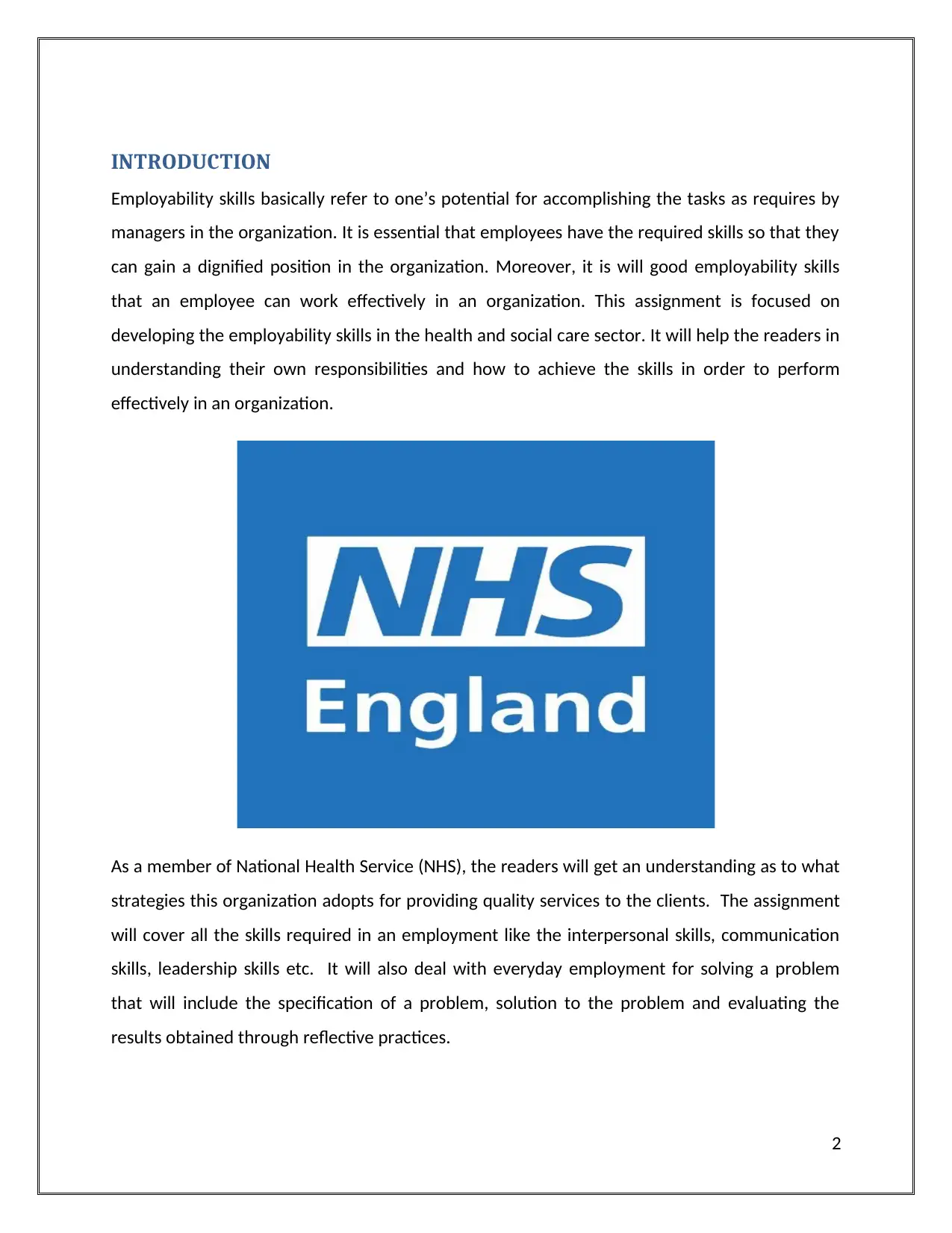
INTRODUCTION
Employability skills basically refer to one’s potential for accomplishing the tasks as requires by
managers in the organization. It is essential that employees have the required skills so that they
can gain a dignified position in the organization. Moreover, it is will good employability skills
that an employee can work effectively in an organization. This assignment is focused on
developing the employability skills in the health and social care sector. It will help the readers in
understanding their own responsibilities and how to achieve the skills in order to perform
effectively in an organization.
As a member of National Health Service (NHS), the readers will get an understanding as to what
strategies this organization adopts for providing quality services to the clients. The assignment
will cover all the skills required in an employment like the interpersonal skills, communication
skills, leadership skills etc. It will also deal with everyday employment for solving a problem
that will include the specification of a problem, solution to the problem and evaluating the
results obtained through reflective practices.
2
Employability skills basically refer to one’s potential for accomplishing the tasks as requires by
managers in the organization. It is essential that employees have the required skills so that they
can gain a dignified position in the organization. Moreover, it is will good employability skills
that an employee can work effectively in an organization. This assignment is focused on
developing the employability skills in the health and social care sector. It will help the readers in
understanding their own responsibilities and how to achieve the skills in order to perform
effectively in an organization.
As a member of National Health Service (NHS), the readers will get an understanding as to what
strategies this organization adopts for providing quality services to the clients. The assignment
will cover all the skills required in an employment like the interpersonal skills, communication
skills, leadership skills etc. It will also deal with everyday employment for solving a problem
that will include the specification of a problem, solution to the problem and evaluating the
results obtained through reflective practices.
2
⊘ This is a preview!⊘
Do you want full access?
Subscribe today to unlock all pages.

Trusted by 1+ million students worldwide
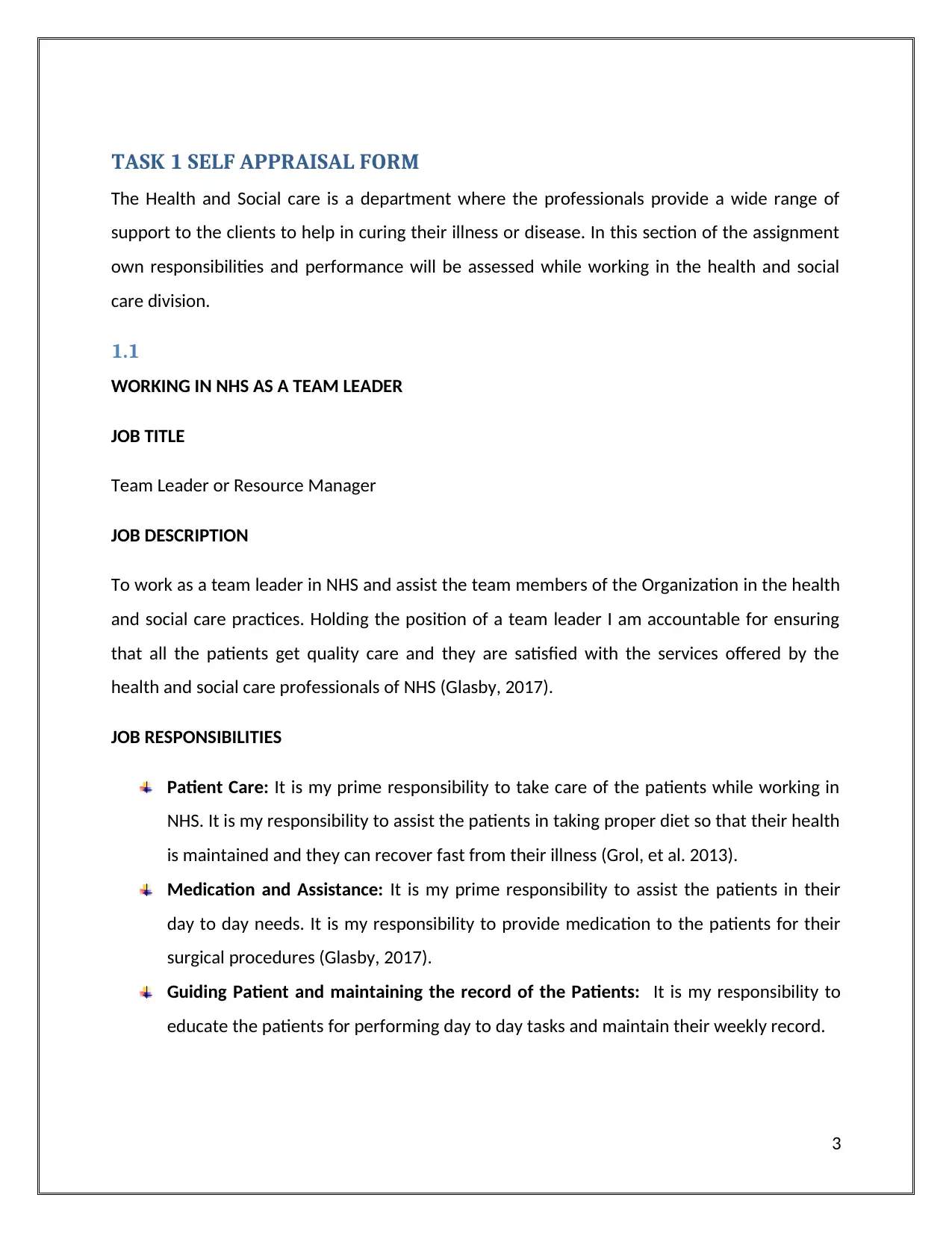
TASK 1 SELF APPRAISAL FORM
The Health and Social care is a department where the professionals provide a wide range of
support to the clients to help in curing their illness or disease. In this section of the assignment
own responsibilities and performance will be assessed while working in the health and social
care division.
1.1
WORKING IN NHS AS A TEAM LEADER
JOB TITLE
Team Leader or Resource Manager
JOB DESCRIPTION
To work as a team leader in NHS and assist the team members of the Organization in the health
and social care practices. Holding the position of a team leader I am accountable for ensuring
that all the patients get quality care and they are satisfied with the services offered by the
health and social care professionals of NHS (Glasby, 2017).
JOB RESPONSIBILITIES
Patient Care: It is my prime responsibility to take care of the patients while working in
NHS. It is my responsibility to assist the patients in taking proper diet so that their health
is maintained and they can recover fast from their illness (Grol, et al. 2013).
Medication and Assistance: It is my prime responsibility to assist the patients in their
day to day needs. It is my responsibility to provide medication to the patients for their
surgical procedures (Glasby, 2017).
Guiding Patient and maintaining the record of the Patients: It is my responsibility to
educate the patients for performing day to day tasks and maintain their weekly record.
3
The Health and Social care is a department where the professionals provide a wide range of
support to the clients to help in curing their illness or disease. In this section of the assignment
own responsibilities and performance will be assessed while working in the health and social
care division.
1.1
WORKING IN NHS AS A TEAM LEADER
JOB TITLE
Team Leader or Resource Manager
JOB DESCRIPTION
To work as a team leader in NHS and assist the team members of the Organization in the health
and social care practices. Holding the position of a team leader I am accountable for ensuring
that all the patients get quality care and they are satisfied with the services offered by the
health and social care professionals of NHS (Glasby, 2017).
JOB RESPONSIBILITIES
Patient Care: It is my prime responsibility to take care of the patients while working in
NHS. It is my responsibility to assist the patients in taking proper diet so that their health
is maintained and they can recover fast from their illness (Grol, et al. 2013).
Medication and Assistance: It is my prime responsibility to assist the patients in their
day to day needs. It is my responsibility to provide medication to the patients for their
surgical procedures (Glasby, 2017).
Guiding Patient and maintaining the record of the Patients: It is my responsibility to
educate the patients for performing day to day tasks and maintain their weekly record.
3
Paraphrase This Document
Need a fresh take? Get an instant paraphrase of this document with our AI Paraphraser
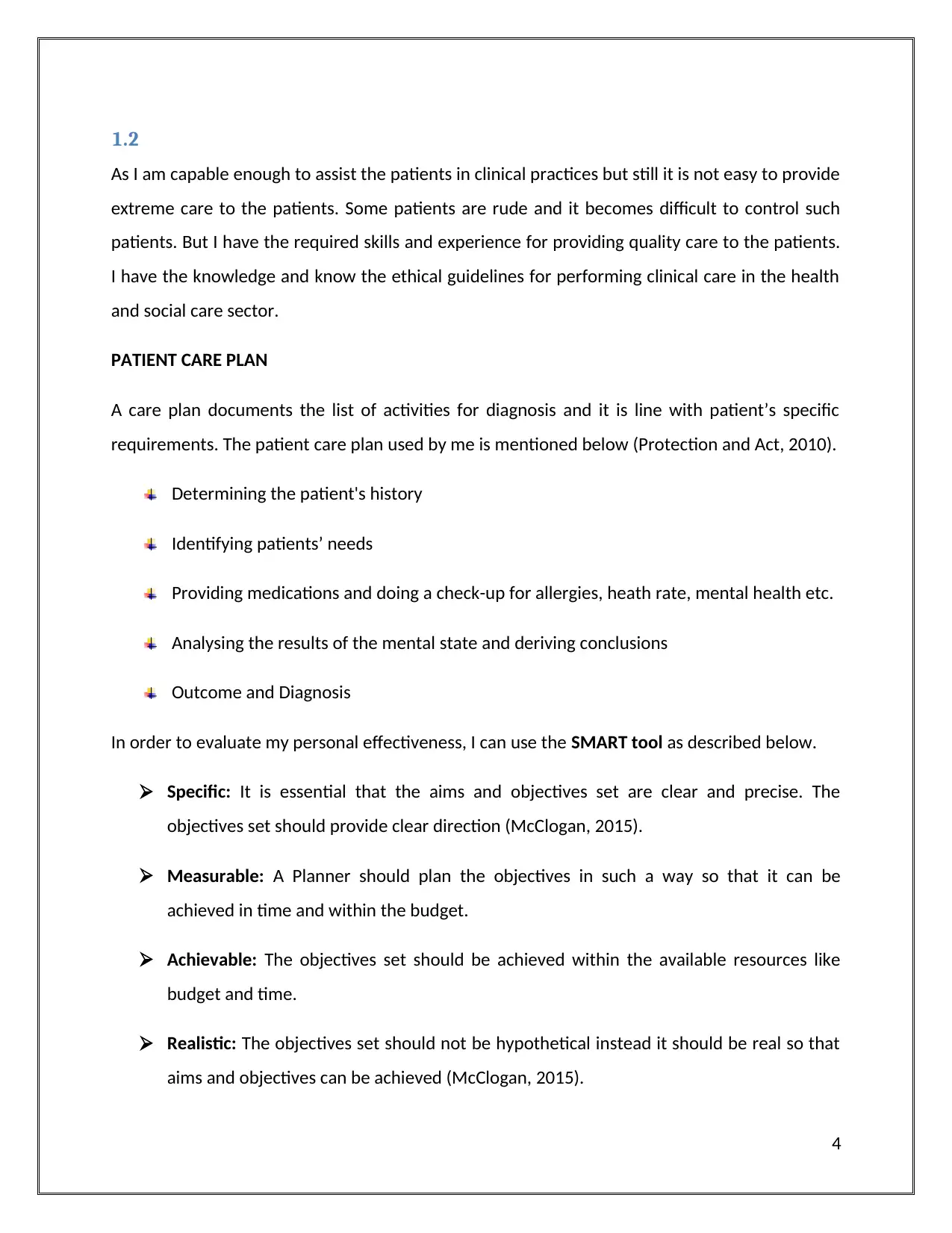
1.2
As I am capable enough to assist the patients in clinical practices but still it is not easy to provide
extreme care to the patients. Some patients are rude and it becomes difficult to control such
patients. But I have the required skills and experience for providing quality care to the patients.
I have the knowledge and know the ethical guidelines for performing clinical care in the health
and social care sector.
PATIENT CARE PLAN
A care plan documents the list of activities for diagnosis and it is line with patient’s specific
requirements. The patient care plan used by me is mentioned below (Protection and Act, 2010).
Determining the patient's history
Identifying patients’ needs
Providing medications and doing a check-up for allergies, heath rate, mental health etc.
Analysing the results of the mental state and deriving conclusions
Outcome and Diagnosis
In order to evaluate my personal effectiveness, I can use the SMART tool as described below.
Specific: It is essential that the aims and objectives set are clear and precise. The
objectives set should provide clear direction (McClogan, 2015).
Measurable: A Planner should plan the objectives in such a way so that it can be
achieved in time and within the budget.
Achievable: The objectives set should be achieved within the available resources like
budget and time.
Realistic: The objectives set should not be hypothetical instead it should be real so that
aims and objectives can be achieved (McClogan, 2015).
4
As I am capable enough to assist the patients in clinical practices but still it is not easy to provide
extreme care to the patients. Some patients are rude and it becomes difficult to control such
patients. But I have the required skills and experience for providing quality care to the patients.
I have the knowledge and know the ethical guidelines for performing clinical care in the health
and social care sector.
PATIENT CARE PLAN
A care plan documents the list of activities for diagnosis and it is line with patient’s specific
requirements. The patient care plan used by me is mentioned below (Protection and Act, 2010).
Determining the patient's history
Identifying patients’ needs
Providing medications and doing a check-up for allergies, heath rate, mental health etc.
Analysing the results of the mental state and deriving conclusions
Outcome and Diagnosis
In order to evaluate my personal effectiveness, I can use the SMART tool as described below.
Specific: It is essential that the aims and objectives set are clear and precise. The
objectives set should provide clear direction (McClogan, 2015).
Measurable: A Planner should plan the objectives in such a way so that it can be
achieved in time and within the budget.
Achievable: The objectives set should be achieved within the available resources like
budget and time.
Realistic: The objectives set should not be hypothetical instead it should be real so that
aims and objectives can be achieved (McClogan, 2015).
4
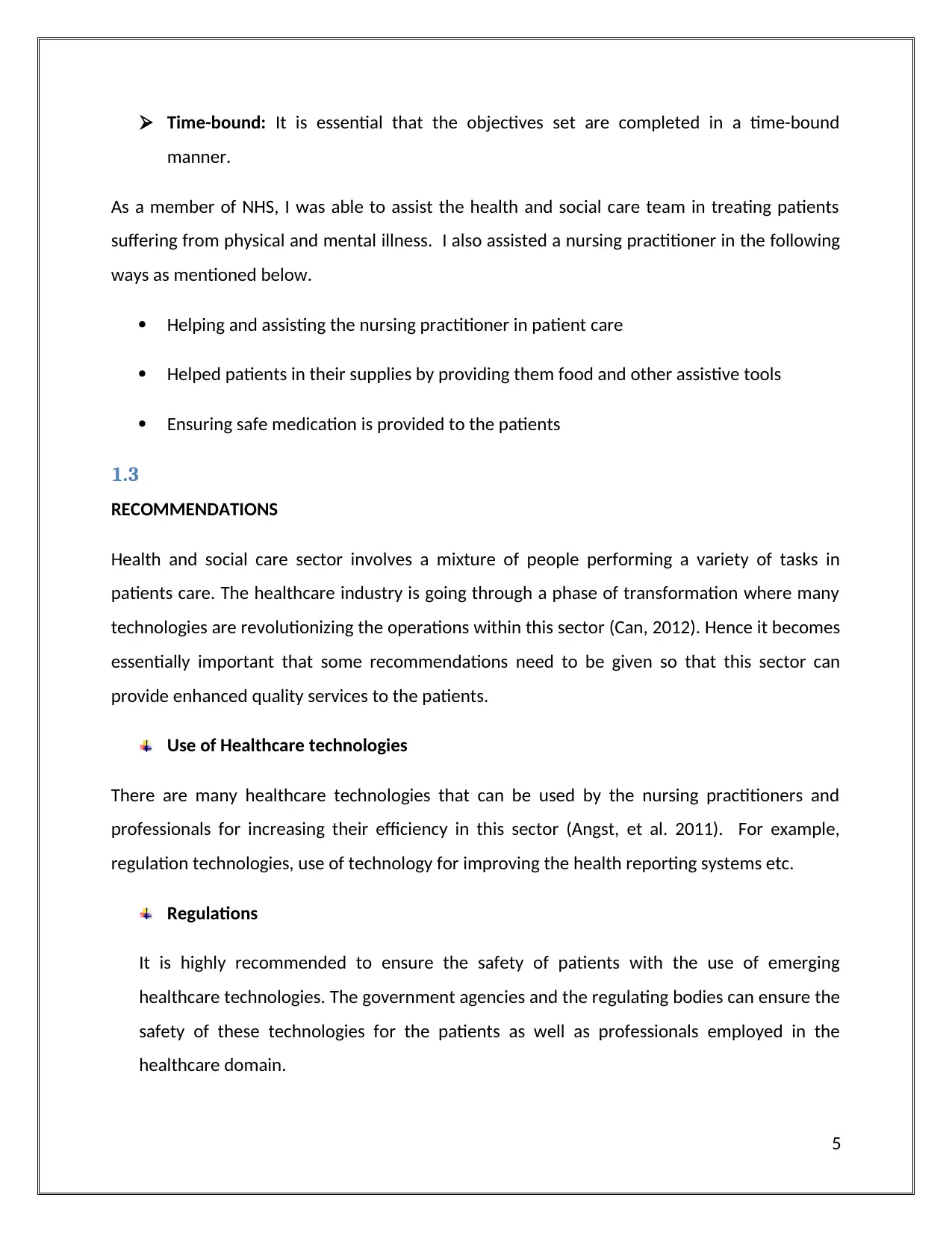
Time-bound: It is essential that the objectives set are completed in a time-bound
manner.
As a member of NHS, I was able to assist the health and social care team in treating patients
suffering from physical and mental illness. I also assisted a nursing practitioner in the following
ways as mentioned below.
Helping and assisting the nursing practitioner in patient care
Helped patients in their supplies by providing them food and other assistive tools
Ensuring safe medication is provided to the patients
1.3
RECOMMENDATIONS
Health and social care sector involves a mixture of people performing a variety of tasks in
patients care. The healthcare industry is going through a phase of transformation where many
technologies are revolutionizing the operations within this sector (Can, 2012). Hence it becomes
essentially important that some recommendations need to be given so that this sector can
provide enhanced quality services to the patients.
Use of Healthcare technologies
There are many healthcare technologies that can be used by the nursing practitioners and
professionals for increasing their efficiency in this sector (Angst, et al. 2011). For example,
regulation technologies, use of technology for improving the health reporting systems etc.
Regulations
It is highly recommended to ensure the safety of patients with the use of emerging
healthcare technologies. The government agencies and the regulating bodies can ensure the
safety of these technologies for the patients as well as professionals employed in the
healthcare domain.
5
manner.
As a member of NHS, I was able to assist the health and social care team in treating patients
suffering from physical and mental illness. I also assisted a nursing practitioner in the following
ways as mentioned below.
Helping and assisting the nursing practitioner in patient care
Helped patients in their supplies by providing them food and other assistive tools
Ensuring safe medication is provided to the patients
1.3
RECOMMENDATIONS
Health and social care sector involves a mixture of people performing a variety of tasks in
patients care. The healthcare industry is going through a phase of transformation where many
technologies are revolutionizing the operations within this sector (Can, 2012). Hence it becomes
essentially important that some recommendations need to be given so that this sector can
provide enhanced quality services to the patients.
Use of Healthcare technologies
There are many healthcare technologies that can be used by the nursing practitioners and
professionals for increasing their efficiency in this sector (Angst, et al. 2011). For example,
regulation technologies, use of technology for improving the health reporting systems etc.
Regulations
It is highly recommended to ensure the safety of patients with the use of emerging
healthcare technologies. The government agencies and the regulating bodies can ensure the
safety of these technologies for the patients as well as professionals employed in the
healthcare domain.
5
⊘ This is a preview!⊘
Do you want full access?
Subscribe today to unlock all pages.

Trusted by 1+ million students worldwide
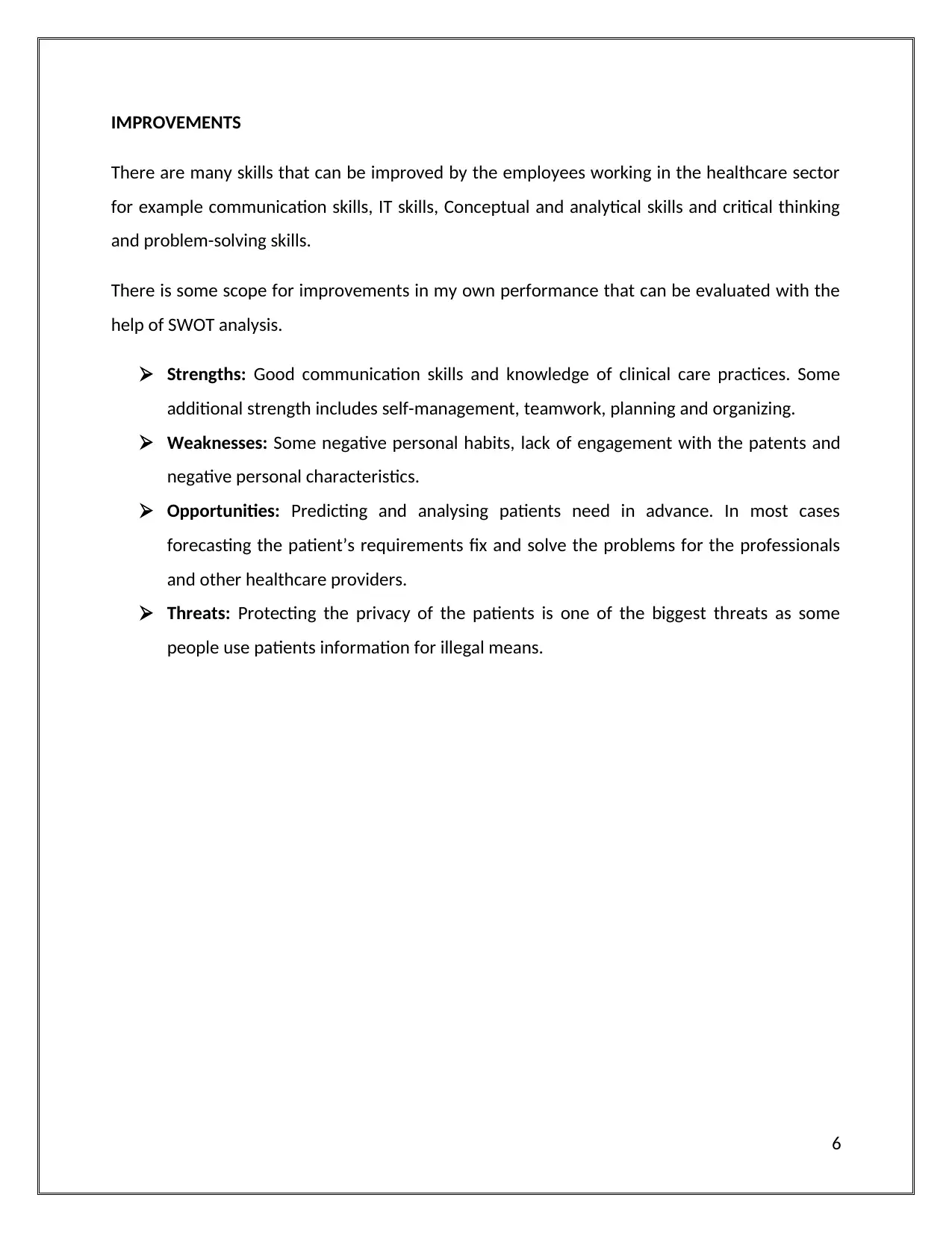
IMPROVEMENTS
There are many skills that can be improved by the employees working in the healthcare sector
for example communication skills, IT skills, Conceptual and analytical skills and critical thinking
and problem-solving skills.
There is some scope for improvements in my own performance that can be evaluated with the
help of SWOT analysis.
Strengths: Good communication skills and knowledge of clinical care practices. Some
additional strength includes self-management, teamwork, planning and organizing.
Weaknesses: Some negative personal habits, lack of engagement with the patents and
negative personal characteristics.
Opportunities: Predicting and analysing patients need in advance. In most cases
forecasting the patient’s requirements fix and solve the problems for the professionals
and other healthcare providers.
Threats: Protecting the privacy of the patients is one of the biggest threats as some
people use patients information for illegal means.
6
There are many skills that can be improved by the employees working in the healthcare sector
for example communication skills, IT skills, Conceptual and analytical skills and critical thinking
and problem-solving skills.
There is some scope for improvements in my own performance that can be evaluated with the
help of SWOT analysis.
Strengths: Good communication skills and knowledge of clinical care practices. Some
additional strength includes self-management, teamwork, planning and organizing.
Weaknesses: Some negative personal habits, lack of engagement with the patents and
negative personal characteristics.
Opportunities: Predicting and analysing patients need in advance. In most cases
forecasting the patient’s requirements fix and solve the problems for the professionals
and other healthcare providers.
Threats: Protecting the privacy of the patients is one of the biggest threats as some
people use patients information for illegal means.
6
Paraphrase This Document
Need a fresh take? Get an instant paraphrase of this document with our AI Paraphraser
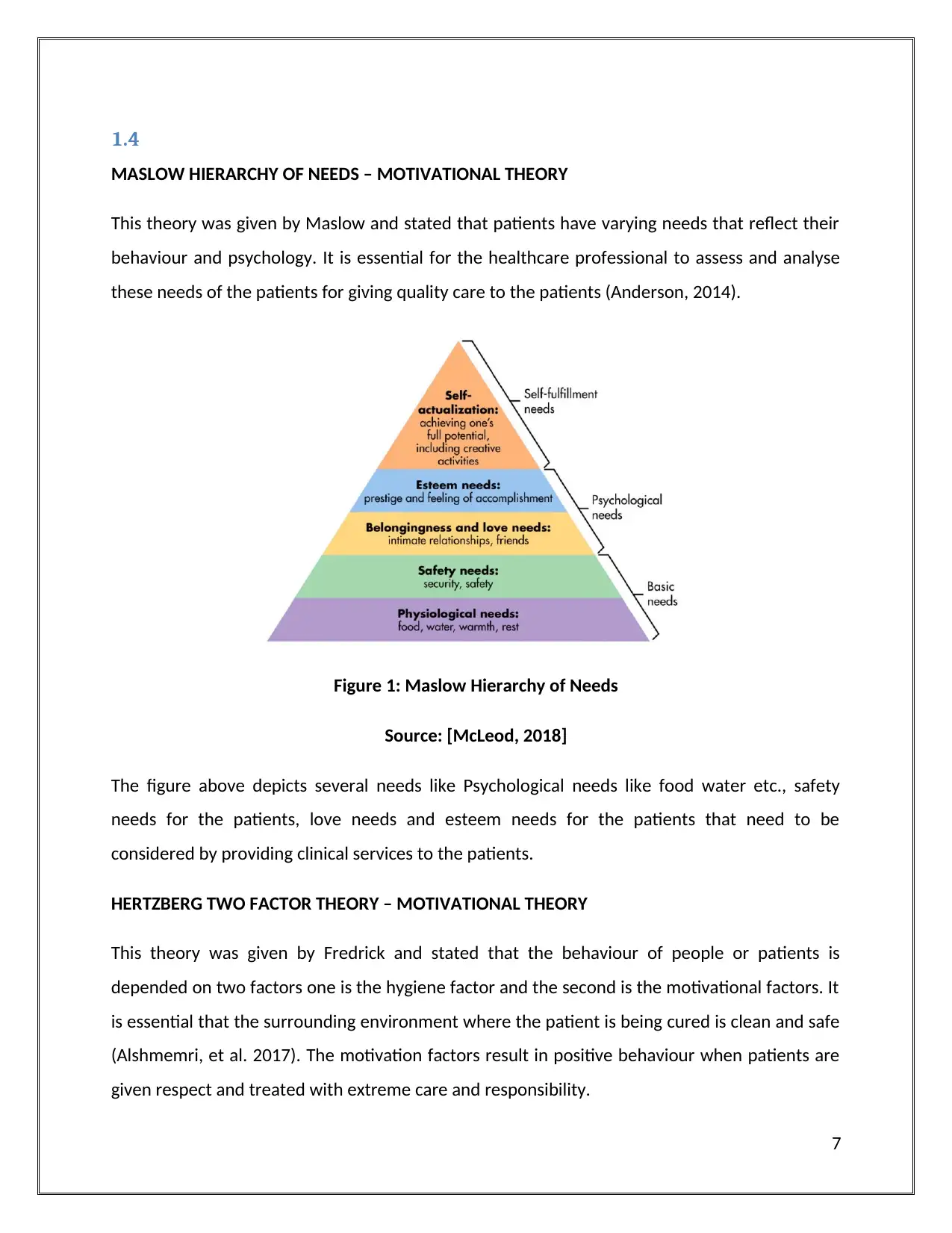
1.4
MASLOW HIERARCHY OF NEEDS – MOTIVATIONAL THEORY
This theory was given by Maslow and stated that patients have varying needs that reflect their
behaviour and psychology. It is essential for the healthcare professional to assess and analyse
these needs of the patients for giving quality care to the patients (Anderson, 2014).
Figure 1: Maslow Hierarchy of Needs
Source: [McLeod, 2018]
The figure above depicts several needs like Psychological needs like food water etc., safety
needs for the patients, love needs and esteem needs for the patients that need to be
considered by providing clinical services to the patients.
HERTZBERG TWO FACTOR THEORY – MOTIVATIONAL THEORY
This theory was given by Fredrick and stated that the behaviour of people or patients is
depended on two factors one is the hygiene factor and the second is the motivational factors. It
is essential that the surrounding environment where the patient is being cured is clean and safe
(Alshmemri, et al. 2017). The motivation factors result in positive behaviour when patients are
given respect and treated with extreme care and responsibility.
7
MASLOW HIERARCHY OF NEEDS – MOTIVATIONAL THEORY
This theory was given by Maslow and stated that patients have varying needs that reflect their
behaviour and psychology. It is essential for the healthcare professional to assess and analyse
these needs of the patients for giving quality care to the patients (Anderson, 2014).
Figure 1: Maslow Hierarchy of Needs
Source: [McLeod, 2018]
The figure above depicts several needs like Psychological needs like food water etc., safety
needs for the patients, love needs and esteem needs for the patients that need to be
considered by providing clinical services to the patients.
HERTZBERG TWO FACTOR THEORY – MOTIVATIONAL THEORY
This theory was given by Fredrick and stated that the behaviour of people or patients is
depended on two factors one is the hygiene factor and the second is the motivational factors. It
is essential that the surrounding environment where the patient is being cured is clean and safe
(Alshmemri, et al. 2017). The motivation factors result in positive behaviour when patients are
given respect and treated with extreme care and responsibility.
7
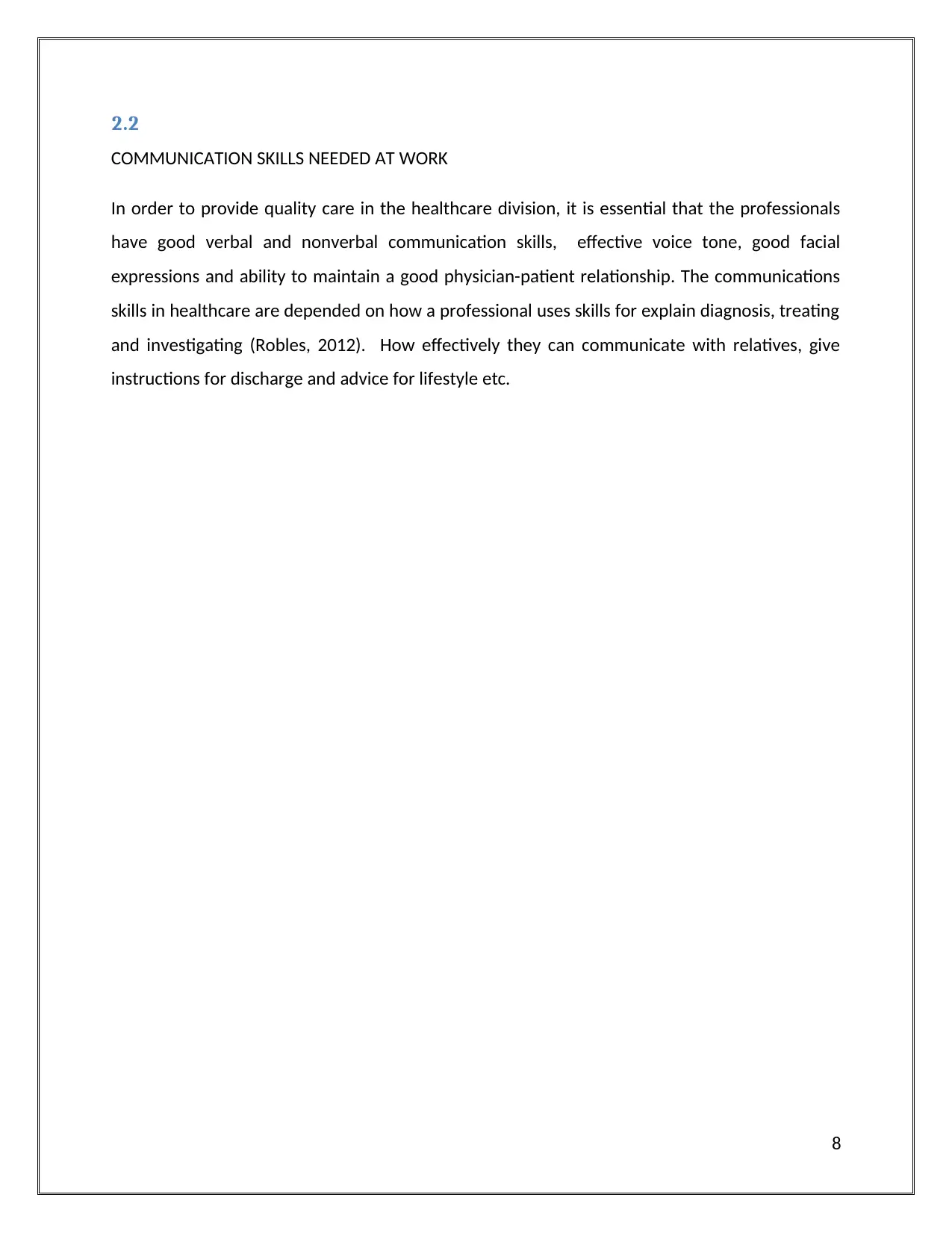
2.2
COMMUNICATION SKILLS NEEDED AT WORK
In order to provide quality care in the healthcare division, it is essential that the professionals
have good verbal and nonverbal communication skills, effective voice tone, good facial
expressions and ability to maintain a good physician-patient relationship. The communications
skills in healthcare are depended on how a professional uses skills for explain diagnosis, treating
and investigating (Robles, 2012). How effectively they can communicate with relatives, give
instructions for discharge and advice for lifestyle etc.
8
COMMUNICATION SKILLS NEEDED AT WORK
In order to provide quality care in the healthcare division, it is essential that the professionals
have good verbal and nonverbal communication skills, effective voice tone, good facial
expressions and ability to maintain a good physician-patient relationship. The communications
skills in healthcare are depended on how a professional uses skills for explain diagnosis, treating
and investigating (Robles, 2012). How effectively they can communicate with relatives, give
instructions for discharge and advice for lifestyle etc.
8
⊘ This is a preview!⊘
Do you want full access?
Subscribe today to unlock all pages.

Trusted by 1+ million students worldwide
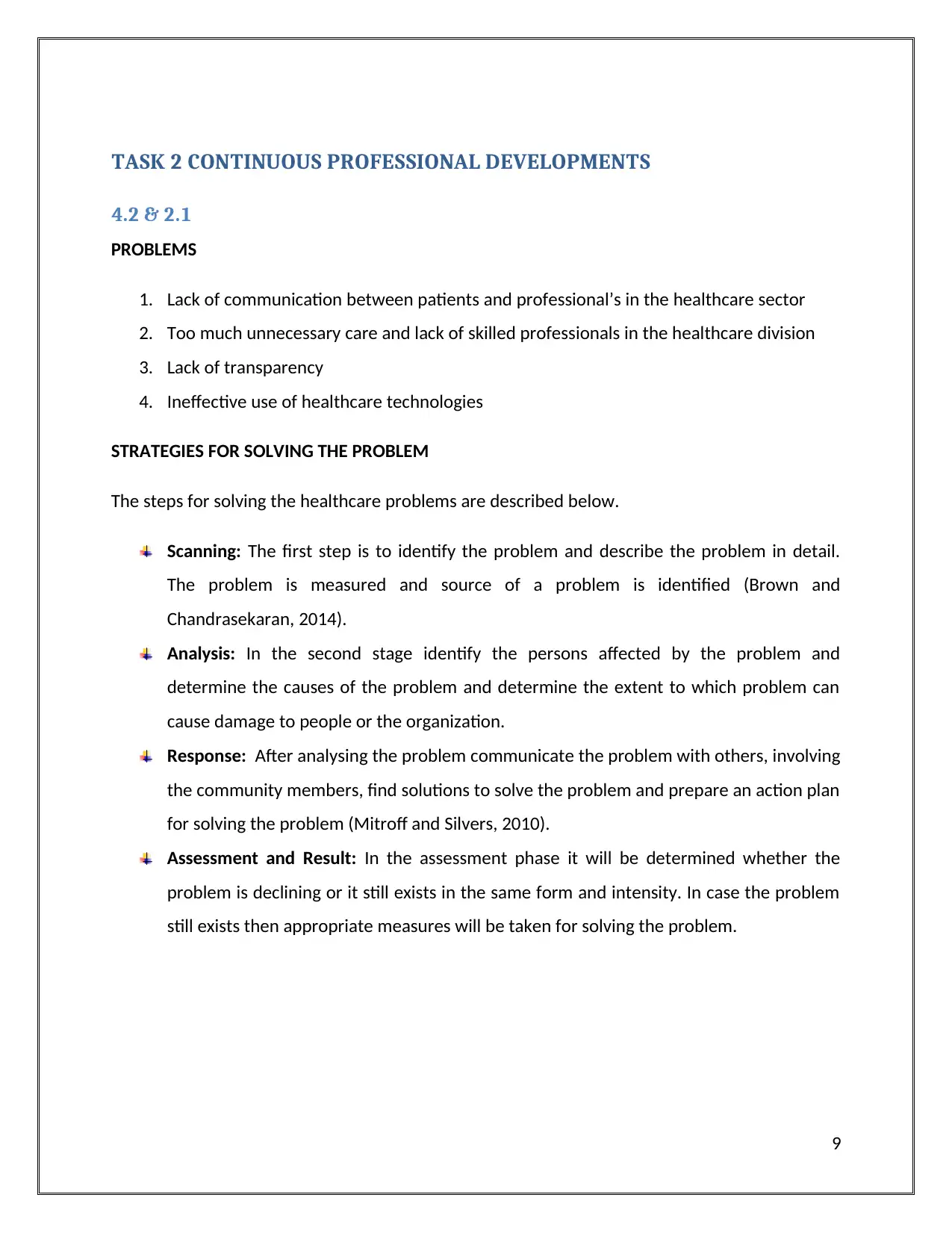
TASK 2 CONTINUOUS PROFESSIONAL DEVELOPMENTS
4.2 & 2.1
PROBLEMS
1. Lack of communication between patients and professional’s in the healthcare sector
2. Too much unnecessary care and lack of skilled professionals in the healthcare division
3. Lack of transparency
4. Ineffective use of healthcare technologies
STRATEGIES FOR SOLVING THE PROBLEM
The steps for solving the healthcare problems are described below.
Scanning: The first step is to identify the problem and describe the problem in detail.
The problem is measured and source of a problem is identified (Brown and
Chandrasekaran, 2014).
Analysis: In the second stage identify the persons affected by the problem and
determine the causes of the problem and determine the extent to which problem can
cause damage to people or the organization.
Response: After analysing the problem communicate the problem with others, involving
the community members, find solutions to solve the problem and prepare an action plan
for solving the problem (Mitroff and Silvers, 2010).
Assessment and Result: In the assessment phase it will be determined whether the
problem is declining or it still exists in the same form and intensity. In case the problem
still exists then appropriate measures will be taken for solving the problem.
9
4.2 & 2.1
PROBLEMS
1. Lack of communication between patients and professional’s in the healthcare sector
2. Too much unnecessary care and lack of skilled professionals in the healthcare division
3. Lack of transparency
4. Ineffective use of healthcare technologies
STRATEGIES FOR SOLVING THE PROBLEM
The steps for solving the healthcare problems are described below.
Scanning: The first step is to identify the problem and describe the problem in detail.
The problem is measured and source of a problem is identified (Brown and
Chandrasekaran, 2014).
Analysis: In the second stage identify the persons affected by the problem and
determine the causes of the problem and determine the extent to which problem can
cause damage to people or the organization.
Response: After analysing the problem communicate the problem with others, involving
the community members, find solutions to solve the problem and prepare an action plan
for solving the problem (Mitroff and Silvers, 2010).
Assessment and Result: In the assessment phase it will be determined whether the
problem is declining or it still exists in the same form and intensity. In case the problem
still exists then appropriate measures will be taken for solving the problem.
9
Paraphrase This Document
Need a fresh take? Get an instant paraphrase of this document with our AI Paraphraser
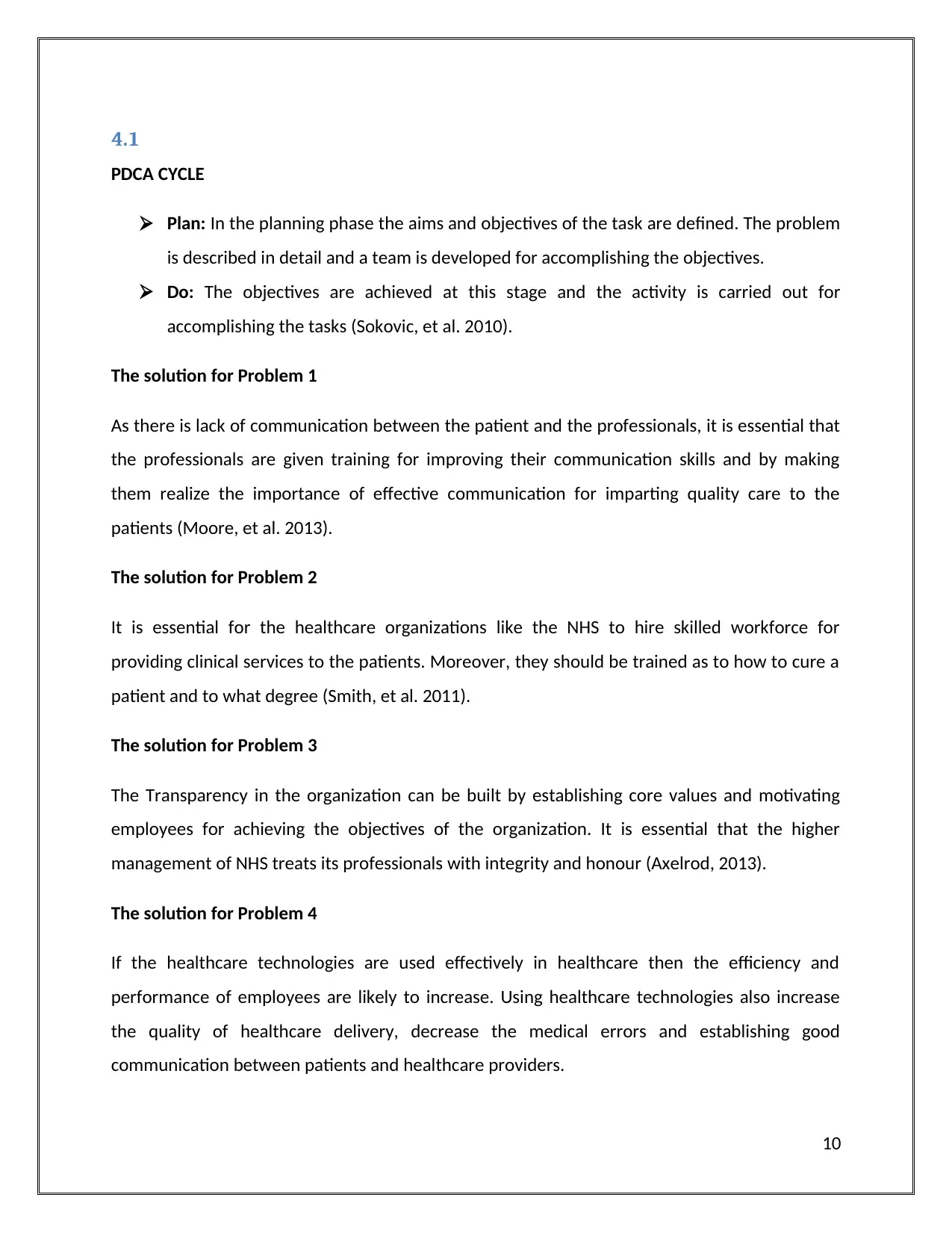
4.1
PDCA CYCLE
Plan: In the planning phase the aims and objectives of the task are defined. The problem
is described in detail and a team is developed for accomplishing the objectives.
Do: The objectives are achieved at this stage and the activity is carried out for
accomplishing the tasks (Sokovic, et al. 2010).
The solution for Problem 1
As there is lack of communication between the patient and the professionals, it is essential that
the professionals are given training for improving their communication skills and by making
them realize the importance of effective communication for imparting quality care to the
patients (Moore, et al. 2013).
The solution for Problem 2
It is essential for the healthcare organizations like the NHS to hire skilled workforce for
providing clinical services to the patients. Moreover, they should be trained as to how to cure a
patient and to what degree (Smith, et al. 2011).
The solution for Problem 3
The Transparency in the organization can be built by establishing core values and motivating
employees for achieving the objectives of the organization. It is essential that the higher
management of NHS treats its professionals with integrity and honour (Axelrod, 2013).
The solution for Problem 4
If the healthcare technologies are used effectively in healthcare then the efficiency and
performance of employees are likely to increase. Using healthcare technologies also increase
the quality of healthcare delivery, decrease the medical errors and establishing good
communication between patients and healthcare providers.
10
PDCA CYCLE
Plan: In the planning phase the aims and objectives of the task are defined. The problem
is described in detail and a team is developed for accomplishing the objectives.
Do: The objectives are achieved at this stage and the activity is carried out for
accomplishing the tasks (Sokovic, et al. 2010).
The solution for Problem 1
As there is lack of communication between the patient and the professionals, it is essential that
the professionals are given training for improving their communication skills and by making
them realize the importance of effective communication for imparting quality care to the
patients (Moore, et al. 2013).
The solution for Problem 2
It is essential for the healthcare organizations like the NHS to hire skilled workforce for
providing clinical services to the patients. Moreover, they should be trained as to how to cure a
patient and to what degree (Smith, et al. 2011).
The solution for Problem 3
The Transparency in the organization can be built by establishing core values and motivating
employees for achieving the objectives of the organization. It is essential that the higher
management of NHS treats its professionals with integrity and honour (Axelrod, 2013).
The solution for Problem 4
If the healthcare technologies are used effectively in healthcare then the efficiency and
performance of employees are likely to increase. Using healthcare technologies also increase
the quality of healthcare delivery, decrease the medical errors and establishing good
communication between patients and healthcare providers.
10
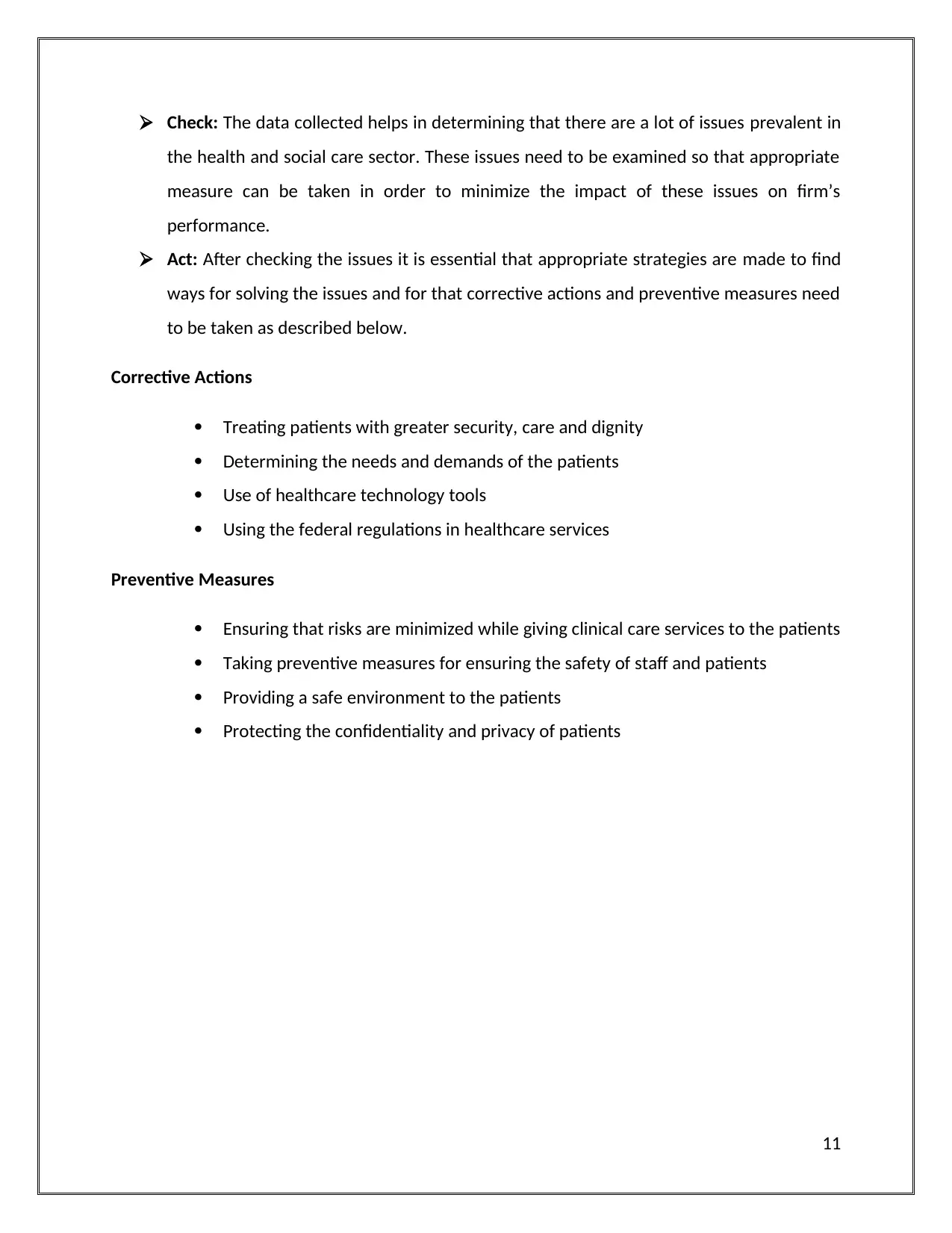
Check: The data collected helps in determining that there are a lot of issues prevalent in
the health and social care sector. These issues need to be examined so that appropriate
measure can be taken in order to minimize the impact of these issues on firm’s
performance.
Act: After checking the issues it is essential that appropriate strategies are made to find
ways for solving the issues and for that corrective actions and preventive measures need
to be taken as described below.
Corrective Actions
Treating patients with greater security, care and dignity
Determining the needs and demands of the patients
Use of healthcare technology tools
Using the federal regulations in healthcare services
Preventive Measures
Ensuring that risks are minimized while giving clinical care services to the patients
Taking preventive measures for ensuring the safety of staff and patients
Providing a safe environment to the patients
Protecting the confidentiality and privacy of patients
11
the health and social care sector. These issues need to be examined so that appropriate
measure can be taken in order to minimize the impact of these issues on firm’s
performance.
Act: After checking the issues it is essential that appropriate strategies are made to find
ways for solving the issues and for that corrective actions and preventive measures need
to be taken as described below.
Corrective Actions
Treating patients with greater security, care and dignity
Determining the needs and demands of the patients
Use of healthcare technology tools
Using the federal regulations in healthcare services
Preventive Measures
Ensuring that risks are minimized while giving clinical care services to the patients
Taking preventive measures for ensuring the safety of staff and patients
Providing a safe environment to the patients
Protecting the confidentiality and privacy of patients
11
⊘ This is a preview!⊘
Do you want full access?
Subscribe today to unlock all pages.

Trusted by 1+ million students worldwide
1 out of 20
Related Documents
Your All-in-One AI-Powered Toolkit for Academic Success.
+13062052269
info@desklib.com
Available 24*7 on WhatsApp / Email
![[object Object]](/_next/static/media/star-bottom.7253800d.svg)
Unlock your academic potential
Copyright © 2020–2025 A2Z Services. All Rights Reserved. Developed and managed by ZUCOL.





